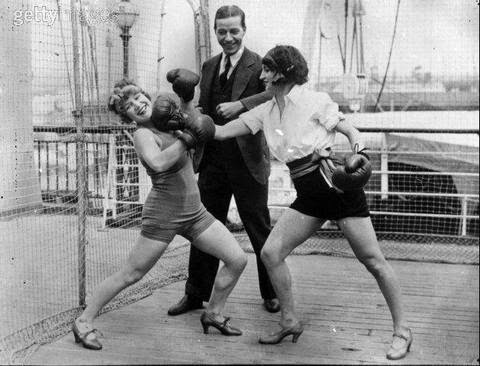Mirella Sichirollo Patzer's Blog, page 22
August 23, 2014
Book Launch! The Novice: A Love Story by Mirella Sichirollo Patzer
Book Launch Announcement!

A young woman on the verge of taking her vows to become a nun.
A desperate flight from a murderous massacre. One honorable man comes to her rescue. Another becomes her nemesis and captor. And a life and death search to reunite with her one true love.
In 10th century Naples, Saracens run rampant, annihilating villages, murdering women and children. Death and despair is everywhere. Alone in the world, Sara is a young novice plagued with doubts about taking her final vows to become a nun. When her convent is attacked, she flees for her life straight into the arms of a group of Saracens who leave her to die alone in the woods. An honorable cavaliere named Nicolo comes to her rescue and offers to take her to the safety of Naples. As they journey together, they are irresistibly drawn to each other. Believing Sara to be a nun, the honorable Nicolo is torn between love and duty to respect her vows. Heartbroken, he does what honor demands and sets her free before she can tell him the truth that she is not a nun. In her search to reunite with Nicolo, she encounters Umberto, a dark and dangerous man who will stop at nothing in his obsession to possess her. With her sharp intellect, and her heart, Sara must rely on her own courage and strength to escape her abuser and find the only man she will ever love. A story that burns with intensity, intrigue, and passion from the author of the highly successful novel, Orphan of the Olive Tree.
I'm so pleased to announce the launch of my latest novel, The Novice: A Love Story. This poignant medieval Italian romance is scheduled for release September 15th, 2014 and is currently available for pre-order in the Amazon Kindle Store. The paperback will be available at a later date.
As a book launch special, the ebook is on sale for $2.99 for the month of September only!
Pre-Order THE NOVICE
Don't have a Kindle?I love my Kindle and my Kindle apps! Between my Kindle, my tablet, and my smart phone, I can read Kindle ebooks on all these devices.










A young woman on the verge of taking her vows to become a nun.
A desperate flight from a murderous massacre. One honorable man comes to her rescue. Another becomes her nemesis and captor. And a life and death search to reunite with her one true love.
In 10th century Naples, Saracens run rampant, annihilating villages, murdering women and children. Death and despair is everywhere. Alone in the world, Sara is a young novice plagued with doubts about taking her final vows to become a nun. When her convent is attacked, she flees for her life straight into the arms of a group of Saracens who leave her to die alone in the woods. An honorable cavaliere named Nicolo comes to her rescue and offers to take her to the safety of Naples. As they journey together, they are irresistibly drawn to each other. Believing Sara to be a nun, the honorable Nicolo is torn between love and duty to respect her vows. Heartbroken, he does what honor demands and sets her free before she can tell him the truth that she is not a nun. In her search to reunite with Nicolo, she encounters Umberto, a dark and dangerous man who will stop at nothing in his obsession to possess her. With her sharp intellect, and her heart, Sara must rely on her own courage and strength to escape her abuser and find the only man she will ever love. A story that burns with intensity, intrigue, and passion from the author of the highly successful novel, Orphan of the Olive Tree.
I'm so pleased to announce the launch of my latest novel, The Novice: A Love Story. This poignant medieval Italian romance is scheduled for release September 15th, 2014 and is currently available for pre-order in the Amazon Kindle Store. The paperback will be available at a later date.
As a book launch special, the ebook is on sale for $2.99 for the month of September only!
Pre-Order THE NOVICE
Don't have a Kindle?I love my Kindle and my Kindle apps! Between my Kindle, my tablet, and my smart phone, I can read Kindle ebooks on all these devices.









Published on August 23, 2014 08:16
August 22, 2014
Hoydens of the Week - Boxing elegance
Published on August 22, 2014 17:50
August 16, 2014
The bizarre excentricities and troubled life of Empress Elisabeth - The Fortune Hunter by Daisy Goodwin
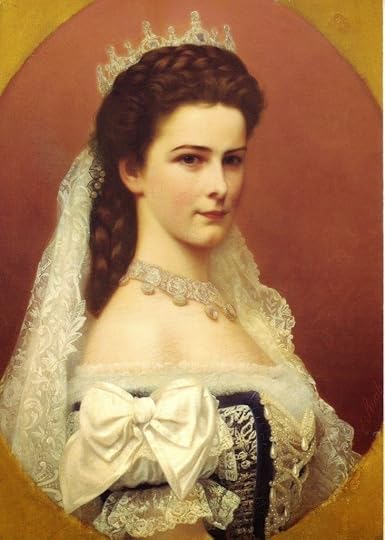
Her Royal Highness Duchess Elisabeth Amalie Eugenie
Elisabeth was the daughter of Duke Maximilian and Princess Ludovika of Bavaria. They lived in Possenhofen Castle, away from the hubbub of the royal court. Sisi and her siblings enjoyed great freedom as children and she developed a grand passion for horseback riding in the beautiful countryside surrounding their castle.

Possenhofen Castle
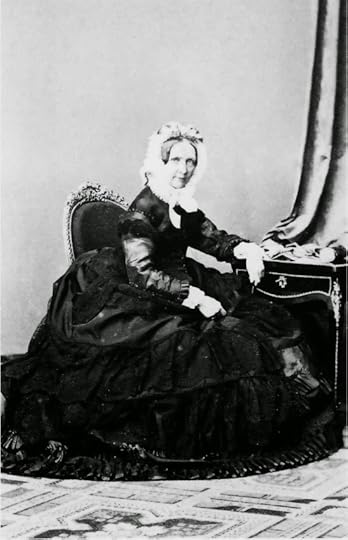
Princess Sophie of BavariaMother of Franz Joseph
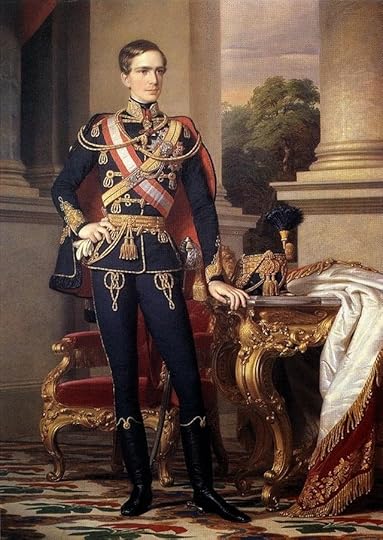
Franz Joseph
Princess Sophie of Bavaria, the domineering mother of 23-year-old Emperor Franz Joseph, arranged a betrothal to her neice, Helene, Sisi’s elder sister. Despite the fact they were in mourning because of the death of a member of the Bavarian royal family, Helene, Sisi, and their mother traveled to Bad Ischl to formalize the betrothal. They traveled in a large entourage, but arrived late due to their mother suffering a migraine. The carriage that carried their fancy dresses and gowns did not arrive in time, so they had to greet the young Franz Joseph dressed in their black mourning clothes. Helene and Franz did not hit it off. Rather, it was Sisi who attracted Franz Joseph’s attention. She was tall, slim, and very beautiful at 5’8” tall and 110 lbs. Much to Princess Sophie's chagrin, he dug his heels in and refused to propose to Helene. He told his mother that if he could not marry Elisabeth, he would not marry at all. Five days later, the betrothal with Sisi was formally announced. The young couple were married eight months later in the spring of 1854.Sisi was only 16 years old and woefully unprepared for married life. Traumatized by the consummation of the marriage on the wedding night, she remained secluded in her bedroom for three days, refusing to come out. Afterward, she struggled to adapt to the Habsburg court life with its rigid expectations and practices and stringent etiquette. Before long, she fell ill, but her illness turned out to be her first pregancy.
She gave birth to her first child. Princess Sophie, who never warmed to Sisi, took matters into her own hands and named the baby after herself, Sophie, without consulting Sisi. She took complete control over the baby and refused to allow Sisi to breastfeed or care for her daughter. The same thing happened when Sisi's second daughter, Gisela was born. Sophie grew more displeased with Sisi when she failed to produce a male heir and began to resent Sisi’s influence upon Franz Joseph. It wasn’t until Sisi travelled to Hungary with her husband and daughters that she truly found respite from the stress and pressures of her mother-in-law and royal life in Austria. She warmed to the Hungarian people and in return, they adored her. Her joy in Hungary was short lived, however. Both her daughters became ill with diarrhea or typhus. Gisela survived, but Sophie died. Her daughter's death drove Sisi into a dark and severe depression that she would never escape for the rest of her life. Her melancholy was so profound, she began neglecting little Gisela, and the distance between them would exist for the rest of their lives. Everyone hoped that when Sisi became pregnant again, it would pull her out of the darkness.But her struggles continued. Sisi missed her loving parents and the freedom of her previous life. She struggled to find her own identity amid the royal duties and responsibilities thrust upon her. She had no control over her life and struggled with being an empress, wife, and mother.
In her own way, she tried to recreate her childhood with all its freedomsm but found that the only thing she could control was her physical appearance. This she did obsessively, and became meticulous with every detail of her beauty, dress, and physical image.
Still mourning for her daughter, Elisabeth refused to eat for days; something that became a habit whenever her depression worsened. She avoided family dinners and if her weight increased even a little, she would fast. She abhorred meat, prefering a diet of milk and eggs. To emphasize her extreme slenderness, she practiced tight-lacing.
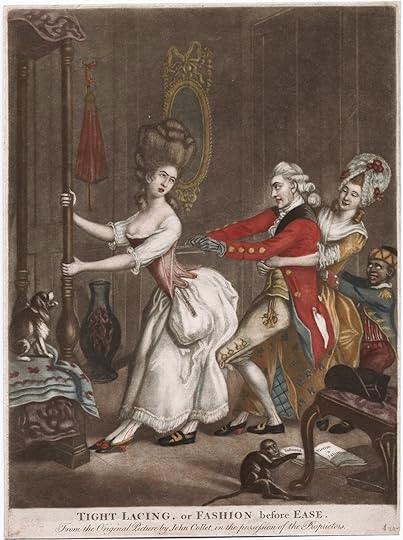
When Sisi returned home to Vienna, her shrunken waist angered her mother-in-law because she still expected Sisi to produce a male heir. Sisi ignored her mother-in-law and exercised rigorously. She set up gymnasiums in every one of her homes, with some equipment laid out in her bedchambers. She rode and fenced several hours each day until she was considered one of the top equestrians in the world.
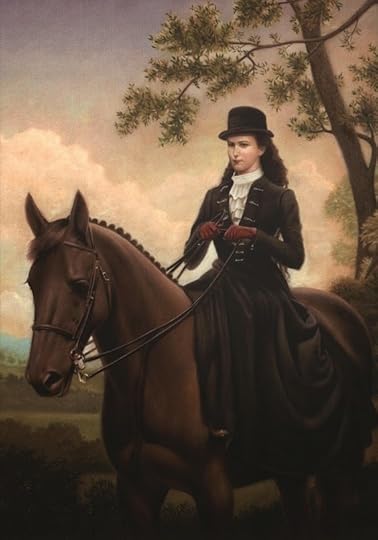
The older she was, the more restless and obsessive she became, constantly weighing herself, taking saunas, and watching what she ate until she became nearly emaciated and weight 95.7 lbs. She also binged-ate, having a secret staircase built into one of her homes direct from her rooms to the kitchen to maintain her secret eating binges.

And then there were her bizarre beauty practices. It took 3 hours per day to care for her thick and extremely long hair.

Franziska FeifalikSisi's Personal Hairdresser
Her hairdresser accompanied her wherever she went. Feifalik was forbidden to wear rings and had to wear white gloves when preparing Sisi's tresses. If any hair fell out, Franziska had to present it to Sisi in a silver bowl and receive her mistress' reproach. Every two weeks, Sisi cancelled all her activities in order to have her hair washed with eggs and cognac. And daily, Franziska had to tweeze out all gray hairs.
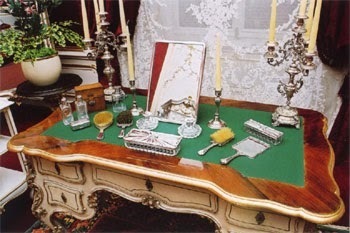
One of Sisi's dressing tablesSisi wore no make-up or perfumes. She preferred beautifying creams and tonics. Her favourite face cream was made from with white wax, spermaceti, sweet almond oil, and rosewater. She also made a nightly facial mask that consisted of raw veal and crushed strawberries. She slept with cloths soaked in either violet or cider-vinegar above her hips to preserve her slim waist, and wrapped her neck with cloths soaked in special tonics. To maintain her peaches and cream complexion, she took both a cold shower every morning and olive oil baths at night.
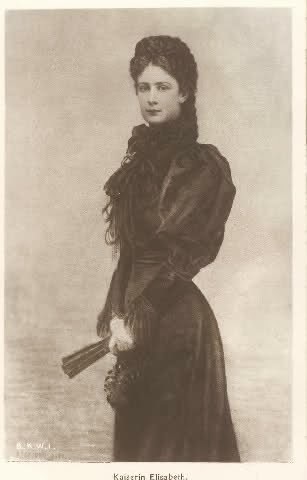
But age ultimately takes it course. After she turned thirty-two, Sisi refused to sit for any more portraits, and would not allow any photographs of her to be taken. Her marriage with Franz Joseph continued to deteriorate, despite the fact he passionately loved her. She saw him as an unimaginative and sober man overly influenced by his domineering mother with her adherences to strict and ceremonial protocols.Elisabeth soon began to distance herself from her husband and fled him and court life whenever possible. Franz Joseph indulged her travels, but always tried to tempt her to come back. Elisabeth suffered with insomniam spent countless hours reading and writing, and took up smoking, a shocking habit, which made her the subject of great gossip. She grew to love the work of Heinrich Hein, a German poet and radical political thinker, exchanging many letters with him.
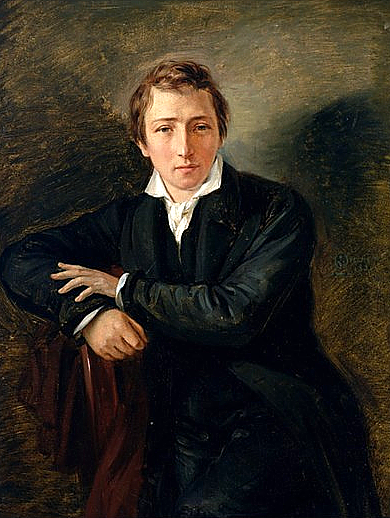
Heinrich Heine
In 1858, Elisabeth finally gave birth to a son named Rudolf. Her influence at court increased, as did her interest in Hungary. She sided with Hungary as conflict increased with Austria. Elisabeth developed a friendship with Hungarian Count Gyula Andrassy. Rumors swirled that they were lovers. While advocating for Hungary, she admonished her husband's stand, and threatened to leave him, unless he compromised and made Andrássy the Premier of Hungary.
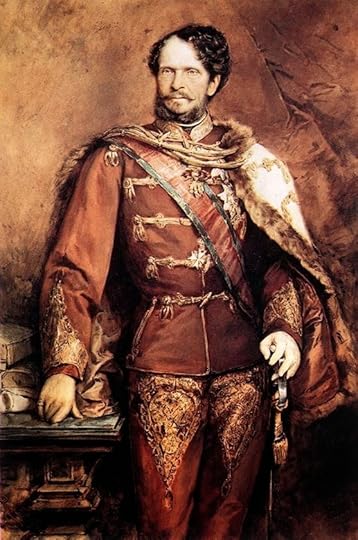
Count Gyula Andrassy
Like her daughters, Sophie blocked Sisi from raising her son, and she openly rebelled. Her nervous attacks, fasting, severe exercise regime, and frequent fits of coughing, and overall health become so alarming, it was reported she suffered from anemia and physial exhaustion. It was feared she had tuberculosis and it was recommended she go to Madeira to recover.
Rumors began to circulate that Franz Joseph was having an affair with an actress. Elisabeth left her husband and children, to spend the winter in seclusion. She returned six months later, but as soon as she returned, she became ill almost immediately with a cough and fever. She barely ate and hardly slept. Her physican recommended she go to Corfu to rest. She improved immediately. It seemed her illnesses improved whenever away from her husband and the royal court, but her eating habits continued to be problematic. She suffered from anemia and dropsy. Her feet were sometimes so swollen she could not walk without support. This time, the doctors recommended she go to a spa in Bad Kissingen to recover. Once again, Elisabeth recovered quickly, but instead of returning home, she went to spend time with her family in Bavaria, which set tongues a wagging about her numerous absences. Two years later, she returned to her husband, but immediately suffered a violent migraine and vomited four times before arriving.
Franz Joseph wanted another son to secure succession. The physicians insisted that Sisi's health could not sustain another pregnancy. She soon fell into her old pattern of escaping the pressures and stress of royal life by frequent walking and riding, using her health as an excuse to avoid official obligations and sexual intimacy. In this way, she succeeded in avoiding her duties as an imperial brood mare and maintained her beauty. Sophie became more confident in her defiance against her husband and mother-in-law. However, her passion for Hungary prevailed and she returned to the marriage bed to ensure a compromise with Hungary was reached and Andrassy was made the first Hungarian prime minister and in return. In return, Andrassy officially crowned Franz Joseph and Elisabeth King and Queen of Hungary.After the coronation gift, a pregnant Sisi went to live in a country residence outside of Budapest. She gave birth to a daughter named Marie Valerie. Determined to bring this last child up by herself, Elisabeth showered all her love on her youngest daughter to the point of nearly smothering her. Sophie's influence over Elisabeth's children gradually faded and she died in 1872.With her children back in her control, however, Elisabeth did not take advantage it. Instead, she she travelled and rarely saw her children. She became the subject of numerous newspaper articles for her obsession with riding and diet regimes, and rumours abounded about her reputed lovers. Her affairs could never be proven, but Franz Joseph's affair with actress Katharina Schratt was very real indeed.
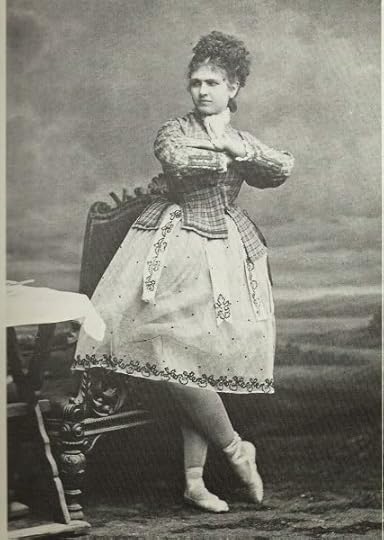
Katharina SchrattEmperor Franz Joseph's MistressIn 1889, her only son, thirty-year-old Rudolf was found dead in a murder suicide with his lover Baroness Mary Vetsera, with Rudolf being the murderer.
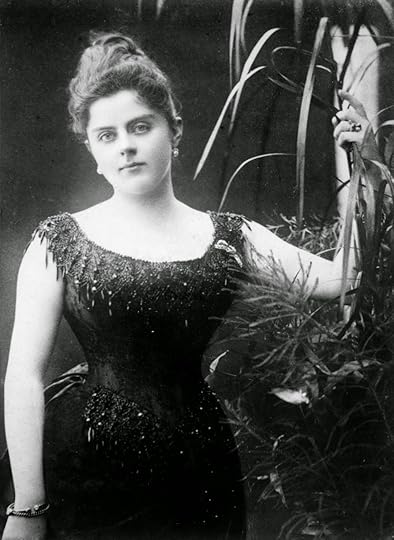
Baroness Mary Vetsera
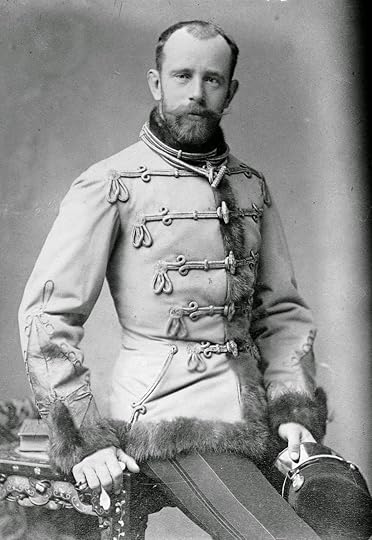
Crown Prince Rudolf of Austria
A profound depression gripped Sisi and she never recovered from it. In the span of one year, she had lost her mother, her father, her sister, and now her son. After Rudolf's death she dressed only in black for the rest of her life. To compound her losses, her one dear friend, Count Gyula Adrassy died a year later. The scandal surrounding the death of her son only increased public interest in Elisabeth, making her an icon with her long black gowns and white leather parasol and fan to conceal her face from the curious.
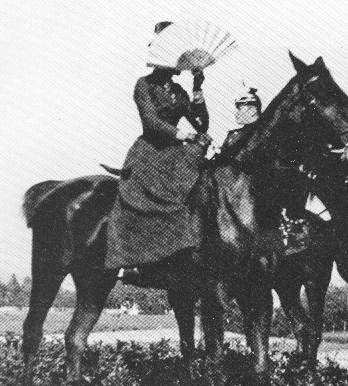
Elisabeth spent little time in Austria's capital Vienna with her husband, and travelled endlessly throughout Europe. Through the exchange of letters, their marriage became a warm friendship. Ignoring warnings of possible assassination attempts, the sixty-year-old Elisabeth traveled incognito to Geneva Switzerland. At 1:35 p.m. on Saturday, 10 September 1898, Elisabeth and her lady-in-waiting left on foot to catch a steamship. A 25-year-old Italian anarchist, Luigi Lucheni, approached and attempting to peer underneath the empress's parasol. As the ship's bell announced the departure, Lucheni seemed to stumble and made a movement with his hand as if he wanted to maintain his balance. Instead, he stabbed Elisabeth with a sharpened needle file that was 4 inches long that he had inserted into a wooden handle.
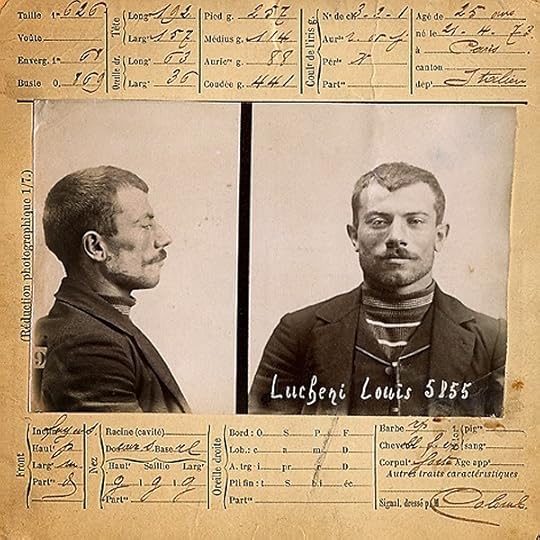
Luigi Lucheni"I am an anarchist by conviction...I came to Geneva to kill a sovereign, with object of giving an example to those who suffer and those who do nothing to improve their social position; it did not matter to me who the sovereign was whom I should kill...It was not a woman I struck, but an Empress; it was a crown that I had in view."The empress collapsed. A coach driver helped her to her feet. The two women walked roughly 100 yards to the gangway and boarded. The empress then lost consciousness and collapsed. Her lady in waiting called for a doctor, but only a former nurse, a fellow passenger, was available. The boat’s captain, ignorant of Elisabeth's identity, advised the countess to disembark and take her companion back to her hotel but the boat had already sailed out of the harbor. Three men carried Elisabeth to the top deck and laid her on a bench. Her lady in waiting opened her gown and cut Elisabeth's corset laces so she could breathe. Elisabeth revived and her lady asked her if she was in pain. Sisi replied, "No. What has happened?" and lost consciousness.Her lady noticed a small brown stain above the Empress' left breast. Alarmed, she informed the captain of her identity, and the boat turned back to Geneva. Sisi was carried back to the Hotel by six sailors on a stretcher improvised from a sail, cushions and two oars. By the time they lifted her from the stretcher to the bed she was clearly dead. Elisabeth's body was returned to Vienna aboard a funeral train. She was entombed in the Church of the Capuchins.After the attack, Lucheni fled but was caught. Although he boasted that he acted alone, precautions were taken for the emperor's protection. At the announcement that an Italian had murdered the Empress, unrest and reprisals were threatened against Italians living in Vienna. Lucheni was brought before the Geneva Court. Furious that the death sentence had been abolished in Geneva, he demanded that he be tried according to the laws of the Canton of Lucerne, which still had the death penalty, signing the letter: “Luigi Lucheni, anarchist, and one of the most dangerous"Elisabeth's will stipulated that a large part of her jewels be sold and the proceeds, over £600,000, were to be applied to various religious and charitable organizations. Franz Joseph remarked to Prince Liechtenstein, "That a man could be found to attack such a woman, whose whole life was spent in doing good and who never injured any person, is to me incomprehensible." Sisi left most of her estate to her granddaughter, the Archduchess Elsabeth, Rudolf's child.
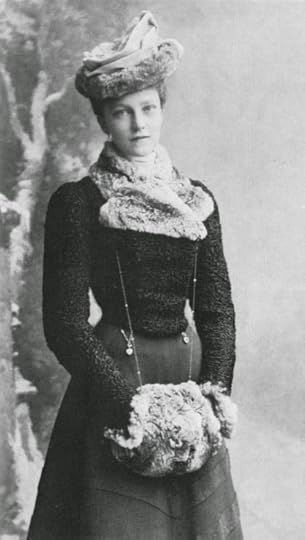
Archduchess Elisabeth
Lucheni was declared sane and was sentenced to life. He attempted to kill himself with the sharpened key from a tin of sardines on 20 February 1900. Ten years later, he hanged himself with his belt in his cell after a guard confiscated and destroyed his uncompleted memoirs.
Empress Sisi is one of the characters in the historical romance, The Fortune Hunter by Daisy Goodwin. Although the novel is classified as biographical, it is more about the fictionalized characters than Sisi's detailed life.
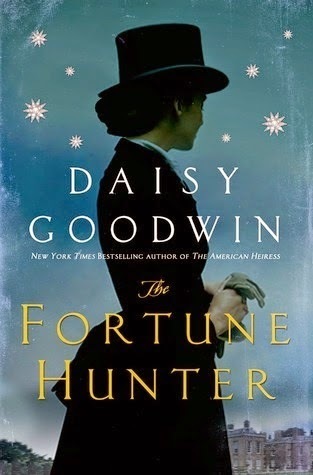
Book Synopsis
Empress Elizabeth of Austria, known as Sisi, is the Princess Diana of nineteenth-century Europe. Famously beautiful, as captured in a portrait with diamond stars in her hair, she is unfulfilled in her marriage to the older Emperor Franz Joseph. Sisi has spent years evading the stifling formality of royal life on her private train or yacht or, whenever she can, on the back of a horse.
Captain Bay Middleton is dashing, young, and the finest horseman in England. He is also impoverished, with no hope of buying the horse needed to win the Grand National—until he meets Charlotte Baird. A clever, plainspoken heiress whose money gives her a choice among suitors, Charlotte falls in love with Bay, the first man to really notice her, for his vulnerability as well as his glamour. When Sisi joins the legendary hunt organized by Earl Spencer in England, Bay is asked to guide her on the treacherous course. Their shared passion for riding leads to an infatuation that jeopardizes the growing bond between Bay and Charlotte, and threatens all of their futures.
The Fortune Hunter, a brilliant new novel by Daisy Goodwin, is a lush, irresistible story of the public lives and private longings of grand historical figures.
Book Reviewby Mirella Patzer
Although this novel is classified as a biographical novel, I believe this is only partially true. Yes, Empress Cisi is one of several main characters, but the book is truly about a romance between the fictionalized characters, Captain Bay Middleton and Charlotte Biard. Cisi's life is only partially, and not thoroughly depicted.
Having said this, I truly enjoyed this novel. It was well written, lush in its descriptions of the era as it pertained to surroundings, fashion, and glamour, and poignant enough to capture my interest until the very last page. The author did an excellent job of describing traditional fox hunts and equestrian skills. I especially enjoyed the quippy and comical interactions with Queen Victoria. Although I'm not sure that the story adheres to historical facts, it does not take away from the enjoyment of the novel. The story gains momentum as it nears a very satisfying ending.As long as readers are aware this isn't a true to form biographical novel about Empress Elisabeth, there is much to recommend this wonderful story.









Published on August 16, 2014 16:30
August 15, 2014
Hoydens of the Week - The start of a new fitness craze

These hoydens dared to bare their legs to begin a new fitness craze better known as Aquasize. Who knew?!o









Published on August 15, 2014 16:48
August 11, 2014
The Marital Escapades of Joan of Kent - A Triple Knot by Emma Campion

Joan of Kent,
Countess of Kent
Lady Wake of Liddell
Countess of Salisbury
Princess of Wales"The most beautiful woman in all England, and the most loving.”Jean FroissartMedieval Chronicler
Joan of Kent, also known as the Fair Maid of Kent, was the most beautiful woman in 14th century England. With such great beauty, and a good head upon her shoulders, Joan managed to catch the attention of many men. With three such men, Joan exchanged clandestine betrothal or marriage vows with.
When she was two years old, her father, Edmund of Woodstock, 1st Earl of Kent (half-brother to King Edward II of England) was executed for treason for supporting his brother against Queen Isabella of France and Roger Mortimer. After her father's execution, Joan, her mother, and her siblings were placed under house arrest in Arundel Castle under the guardianship of Catherine and William Montacute.
Clandestine marriage #1
When Queen Isabella's son, Edward III, became old enough, he rejected the regency of his mother Isabella and Roger Mortimer, and placed himself on the throne. He and his wife, Queen Philippa of Hainault, brought Joan to court, where she grew up among her royal cousins.
An especially close bond developed between Joan and the king and queen's son, Edward of Woodstock (Ned) the Black Prince. Ned was almost two years younger than Joan, but he was more than smitten with his beautiful elder cousin. As children, the two exchanged pretend marital vows. Ned was determined to make Joan his queen one day, despite the fact he knew his parents would never approve a union with the daughter of a treasonous traitor.

The Dance of the Garter
The idea for the creation of the knightly Order of the Garter was attributed to Joan of Kent

Ned, the Black Prince being conferred as a Knight in the Order of the Garter,established by his father, Edward III
Clandestine marriage #2
When Joan turned 12, she met Thomas Holland, a knight. She fell deeply in love with the kind-hearted man, as he did with her. Although the king and queen arranged a betrothal with William Montacute, the son of Catherine and William Montacute, she followed her heart and secretly married Thomas Holland. Joan was the cousin of the king, and as a royal woman, she was expected to marry only with the permission of the king in a union that would benefit the country. Otherwise, she might face charges of treason which carried a penalty of execution. But despite the penalty of death, Thomas and Joan loved each other so much, they risked all to be together. Shortly after their clandestine marriage vows, Thomas Holland was sent away on a long military mission. Their separation would prove to be a long one. Joan kept her marriage secret, and the king and queen proceeded with their plans to betroth Joan to the disinterested William Montacute, the son of her guardians.
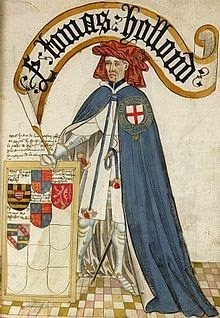
Thomas Holland
When Thomas Holland's campaign ended and he returned to England, he was more than shocked to learn that his wife had been married off to someone else. Determined to fight for his wife, he appealed to the King to have Joan returned to him. Of course, the king refused and so Thomas had to appeal to the Pope, a costly initiative. Meanwhile, the Montacutes, desperate to hang on to Joan because of the royal status she brought to their family, seized her and imprisoned her in a secret location. While Joan was held captive, a plague ravaged England, ultimately claiming Joan's mother.
Trapped in an unhappy marriage with Will, who was more than intimidated by his beautiful, outspoken wife, their sex lives was virtually non-existent. After all, Thomas Holland was the only man Joan loved and wanted. But due process took time and she waited patiently for Thomas to receive a decision from the papal authorities. That decision came when Joan was 21. To their delight, the pope annulled Joan's marriage to William Montacute and allowed her to return to Thomas Holland.
Finally happy, the couple spent eleven joyous years together during which she bore her husband four children and amassed great wealth and titles and bestowments from the king. When Thomas died, Joan was left a very wealthy widow.

Edward III bestowing Ned the title of Prince of Aquitaine
Clandestine marriage #3
Edward the Black Prince had never given up his dreams to make Joan his queen. Now that she was widowed, Edward stepped up his pursuit of her. Knowing that his mother, Queen Philippa, opposed a marriage to Joan, he secretly married Joan, again without the consent or knowledge of the king and queen. This was a problem because they were cousins and special papal dispensation was required in order for them to be considered legally married.
Her first legal marriage
When the king found out about their marriage, he somehow managed to set aside his anger and decided that his son should be married properly, as befit the crown prince. So he had Joan and Ned's clandestine and secret marriage annulled by the Pope. Then he aquired the necessary dispensation so that Joan and Ned could legally wed in a very public royal wedding. Ned was bestowed the title of Prince of Aquitaine, and the coupled established residence there. Joan bore Ned two sons, but sadly, the eldest, another Edward, died at age six.
Ned became involved in a war on behalf of Pedro of Castile, but when Pedro died, the war became financially disastrous. Joan raised an army to protect Aquitaine in her husband's absence. Afterwards, Joan and Ned returned to England with their surviving son, Richard. A few years later, Ned died in 1376. He was buried with pictures of Joan in his crypt.
Mother of a King
The following year, the king died. With no sons to succeed him, Joan and Ned's only surviving son, Richard II, was crowned at the age of 10.
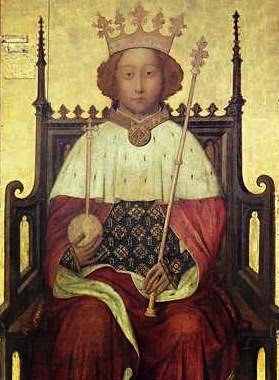
Richard II
As the mother of the young king, Joan enjoyed much privilege and influence. During England's Peasants' Revolt, Joan lost some of her influence over her son. When Joan's older son, John Holland, was condemned to death for killing Ralph Stafford, Joan pleaded for his life, begging Richard II to pardon his half-brother. In this she succeeded. It was to be her last formal act for Joan died several days later.
At her request, Joan was buried beside her beloved first husband, Thomas Holland, at Greyfriars.
The life of this great beauty, Joan of Kent, comes to life the historical biographical novel, A Triple Knot by Emma Campion.
Book Reviewby Mirella Patzer
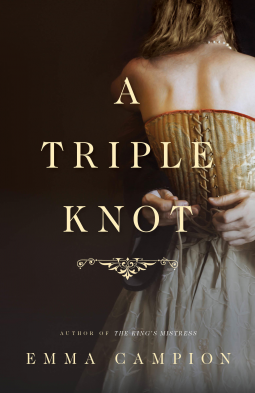
The critically acclaimed author of The King's Mistress brings another fascinating woman from history to life in an enthralling story of political intrigue, personal tragedy, and illicit love.
Joan of Kent, renowned beauty and cousin to King Edward III, is destined for a politically strategic marriage. As the king begins a long dynastic struggle to claim the crown of France, plunging England into the Hundred Years’ War, he negotiates her betrothal to a potential ally and heir of a powerful lordship.
But Joan, haunted by nightmares of her father’s execution at the hands of her treacherous royal kin, fears the king’s selection and is not resigned to her fate. She secretly pledges herself to one of the king’s own knights, one who has become a trusted friend and protector. Now she must defend her vow as the king—furious at Joan’s defiance—prepares to marry her off to another man.
In A Triple Knot, Emma Campion brings Joan, the “Fair Maid of Kent” to glorious life, deftly weaving details of King Edward III’s extravagant court into a rich and emotionally resonant tale of intrigue, love, and betrayal.
In A Triple Knot, author Emma Campion has successfully brought to life the early years of Joan Kent's life. Although the first two chapters of this novel were a little too heavy in backstory and the introduction of far too many names and characters, once I read past this slow beginning, the story started to build and truly captured my interest. The characters are majestically and realistically brought to life, as are the politics and court intrigues of King Edward III's court. Through clever dialogue and rich descriptions, Joan of Kent’s life takes center stage in a most compelling and believable way.
Joan was recreated in an honorable way, showing either her great affection or great distate for her three husbands. Her plight as a pawn is poignant, especially when she risks all to follow her heart instead of her duty to England. And all this while she was in her early teens. Despite all the political minefields she must tread carefully through, Joan was a woman who remained true to herself.
The author's depiction of Joan of Kent and those closest to her was nothing short of delightful. I highly recommend this novel!









Published on August 11, 2014 09:31
August 8, 2014
Hoyden of the Week - Crazy Body Image
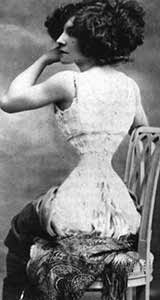
I can't imagine how this woman got herself strapped so tightly into this contraption called a corset and lived to tell about it. That was a hundred years ago. Now we women sweat and run and exercise and weight train to keep our bodies in shape. My, my, my, we've come a long way, haven't we?









Published on August 08, 2014 16:46
August 4, 2014
Elin Ulfsdotter Snakenborg Marchioness of Northampton - Roses Have Thorns: A Novel of Elizaveth I by Sandra Byrd
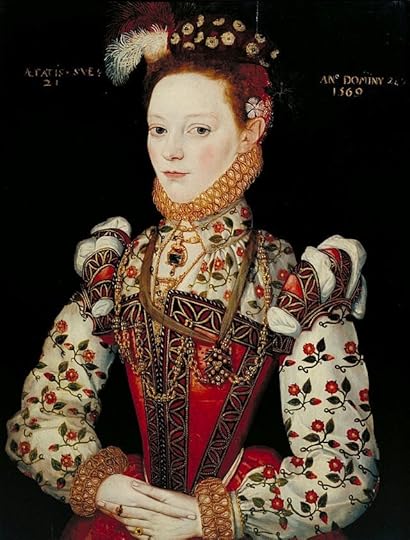
Elin Ulfsdotter SnakenborgMarchioness of NorthamptonAlso known as Helena and Helena the Red
Elin Snakenborg was a Swedish-born noblewoman who became Maid of Honour of Queen Elizabeth I of England, and Marchioness of Northampton by her marriage to William Parr, 1st Marquess of Northampton.
She was one of six Swedish noblewomen in the retinue of Princess Cecilia of Sweden, Margravine of Baden, second-eldest daughter of King Gustav I. The women left Sweden in the autumn of 1564 on a voyage to England, at the invitation of Queen Elizabeth I.

Queen Elizabeth IDaughter of King Henry VIII and Executed Queen Anne Boleyn
Their voyage took almost a year because it was hampered by bad weather and seasickness. When they landed at Dover, Sir William Parr, 1st Marquess of Northampton (1513–1571), the brother of the late Queen consort Catherine Parr, was there to greet them.
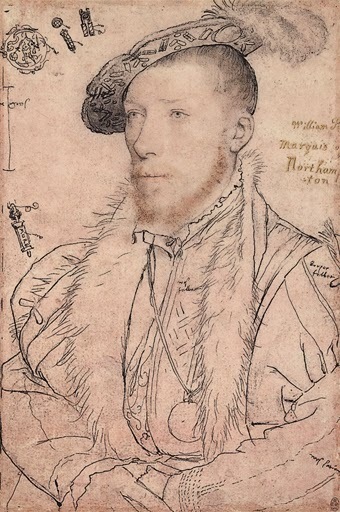
William Parr 1st Marquess of Northampton
The older Marquess of Northampton soon began to court her in earnest, bestowing her with a multitude of extravagant gifts that swept her off her feet. Elin understood the advantages of a rich, aged husband, and possible wealthy widowhood in near future.
When Swedish Princess Cecilia fled England to avoid creditors, Elin remained behind in the service of Queen Elisabeth. But Elin could not marry the Marquess because his first wife from which he had been divorced, was still living and the English Church refused to acknowledge subsequent marriages.
While Erin rose to greater heights and ranks through the gracious gifts and bestowments of Queen Elizabeth who was fond of her. she waited for the Marquess to sort through his past marital/divorce problems. When the ex-wife finally died, the Marquess was free to marry Elin. Their childless marriage, however, was short lived, for he died several months later. Elin became one of the wealthiest women in England and second in rank to the Queen.
Soon, she met Thomas Gorge, Anne Boleyn's second cousin.They fell in love and despite his lower rank and status, they married secretly, much to the chagrin of the queen, who sent Thomas to the Tower and banished Elin from court. However, as one of the queen's favorites, they were soon forgiven and reinstated.
Elin bore Thomas 8 surviving children, and all the while, the queen continued to bestow lavish gifts and estates and titles to Elin and her husband.
Author Sandra Byrd has written a beautiful novel about Elin and her life and loves while at Queen Elizabeth's court.
Roses Have Thorns
From the acclaimed author of To Die For comes a stirring novel told that sheds new light on Elizabeth I and her court.

Book Summary
Like Philippa Gregory and Alison Weir, Sandra Byrd has attracted countless fans for evoking the complexity, grandeur, and brutality of the Tudor period. In her latest tour de force, she poses the question: What happens when serving a queen may cost you your marriage--or your life?
In 1565, seventeen-year-old Elin von Snakenborg leaves Sweden on a treacherous journey to England. Her fiance has fallen in love with her sister and her dowry money has been gambled away, but ahead of her lies an adventure that will take her to the dizzying heights of Tudor power. Transformed through marriage into Helena, the Marchioness of Northampton, she becomes the highest-ranking woman in Elizabeth's circle. But in a court that is surrounded by Catholic enemies who plot the queen's downfall, Helena is forced to choose between her unyielding monarch and the husband she's not sure she can trust--a choice that will provoke catastrophic consequences.
Vividly conjuring the years leading up to the beheading of Mary Queen of Scots, Roses Have Thorns is a brilliant exploration of treason, both to the realm and to the heart.
Book Reviewby Mirella Patzer
If you've never read a novel by Sandra Byrd, then you're in for a real treat. I love that this book brings to life a lesser known woman in the Tudor era. It's a nice change from the over abundance of novels about Henry VIII's wives.
Sandra Byrd had delved deeply and truly brought to life Erin Snakenborg in this fascinating portrayal. Through Erin's eyes, we learn more of Queen Elizabeth, the animosity between her and her half-sister Mary Queen of Scots, the many murder plots to kill her off, and the political turmoil of the era.
With lush descriptions, a compelling first person narrative, brilliant details, and tight dialogue, the author swept me into all the court intrigues of the time. I truly could not stop reading once I began. Historical facts were cleverly weaved into the story, so that keeping track of people, was not onerous. The story follows historical facts closely, which is another definite asset. A great storyline, a compelling heroine, and plenty of intrigue and conflict make this a must read book. I have also read To Die For and The Secret Keeper by Sandra Byrd and they are equally as good. Read all three! They are wonderfully enjoyable.









Published on August 04, 2014 11:49
August 3, 2014
Beautiful Fools: The Last Affair of Zelda and Scott Fitzgerald by R. Clifton Spargo

Zelda FitzgeraldThe Woman behind the Artist(1900 - 1948)AuthorDancer
Now on virtually all high school reading lists, F. Scott Fitzgerald’s novels, especially The Great Gatsby, were initially commercial failures. Although we now consider Fitzgerald one of America’s greatest writers, he died young, penniless, and forgotten, until scholarly research revived his writing and reputation almost half a century later. But, what most don’t know is that his wife, Zelda Fitzgerald, was also a writer--or at least an aspiring one.
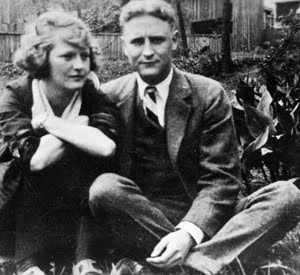
Zelda and F. Scott Fitzgerald
Zelda Sayre Fitzgerald began writing her first book while being treated for schizophrenia at the Phipps Clinic of John Hopkins Hospital in Baltimore. Zelda finished writing her almost entirely autobiographical novel, Save Me the Waltz, in a two-month manic frenzy. She sent her manuscript to the renowned literary editor Maxwell Perkins.
Scott read the book after Zelda sent it out, and he was furious. He had been working for years on what would become Tender is the Night, and he felt that Zelda “plagiarized” the material he was using for his own book, which was also based on the couple’s life together. Scott insisted the book would not sell, calling Zelda a “third-rate writer.” Nonetheless, Perkins agreed to publish her book, although it was, as Scott predicted, received poorly. Save Me the Waltz was later reprinted in 2001.
In Dear Scott, Dearest Zelda, their marriage is documented in a series of love letters. Zelda was an unstable, gregarious socialite, and Scott was jealous, obsessive, and domineering. Still, the letters demonstrate an astoundingly deep affection for one another. Shortly before their marriage, in a letter to a friend, Fitzgerald calmed fears that the marriage might not work: “I fell in love with [Zelda’s] courage, sincerity, and her flaming self-respect, and it’s these things I’d believe in even if the whole world indulged in wild suspicions that she wasn’t all that she should be. But of course the real reason…is that I love her and that’s the beginning and end of everything.”

As Fitzgerald turned to the bottle more and more, Zelda’s behavior grew increasingly erratic. After Save Me the Last Waltz was published, she spent the rest of her adult life in and out of mental hospitals. Although she never published work after her first failed novel, she dabbled in both art and ballet. Her interest in ballet was especially troubling, as she practiced to exhaustion, putting in eight hours of work every day.
When Scott died in Hollywood from a heart attack at 44, Zelda, staying at a hospital in North Carolina at the time, was unable to attend the funeral. Zelda died in a fire at the same hospital eight years later. We emember Zelda, whom her husband proclaimed “the first American flapper,” for her tumultuous love affair with one of America’s greatest artists. Yet she should still be understood as a fascinating figure in her own right, a woman who defined an era.
This guest post is contributed by Pamelia Brown, who writes for the site associate degree . She welcomes your comments at her email Id: pamelia.brown@gmail.com.
A poignant portrayal about the dying love of a famous couple

Book Summary
In this evocative and meticulously detailed novel about the last romance of one of America's greatest literary couples, R. Clifton Spargo crafts an exhilarating portrait of the passionate yet tragically dysfunctional relationship between F. Scott and Zelda Fitzgerald.
In 1939 Scott is living in Hollywood, a virulent alcoholic and deeply in debt. Despite his relationship with gossip columnist Sheila Graham, he remains fiercely loyal to Zelda, his soul mate and muse. In an attempt to fuse together their fractured marriage, Scott arranges a trip to Cuba, where, after a disastrous first night in Havana, the couple runs off to a beach resort outside the city. But even in paradise, Scott and Zelda cannot escape the dangerous intensity of their relationship.
In Beautiful Fools, R. Clifton Spargo gives us a vivid, resplendent, and truly human portrait of the Fitzgeralds, and reveals the heartbreaking patterns and unexpected moments of tenderness that
characterize a great romance in decline.
Book Reviewby Mirella Sichirollo Patzer
Beautiful Fools is a poignant, heartwrenching, and tender portrayal of a couple who desperately try to hang on to a doomed love. Zelda and F. Scott Fitzgerald had risen to great heights, but the Great Depression and drink and mental illness have taken their toll upon their lives and their marriage. So, in 1939, Fitzgerald leaves his mistress and scrapes up enough money to take Zelda out of the mental institution for a vacation in Cuba. This novel spans those precious dwindling few days.
Spargo's portrayal of this famous husband and wife is beautifully rendered depicting Zelda's love for her husband and her attempt to keep any bitterness against him for past faults like not taking her dancing seriously and for writing abouther. Scott on the other hand, struggles to keep his drinking at bay for his wife's sake, his reckless behavior, his lies, his secrets.
This character driven story is a beautiful rendition of their lives, of lost love, of dying dreams, of the struggle to let go of the past. The author has given us an indepth look at the secrets and failures of this very fascinating couple.









Published on August 03, 2014 08:59
July 28, 2014
Book Review - East India by Colin Falconer
A Novel of Mutiny, Murder, and Madness!
The Shipwreck of the Batavia

In any other circumstance but shipwreck, rape and murder, a man like Michiel van Texel would never have met a fine lady such as Cornelia Noorstrandt.
He was just a soldier, a sergeant in the Dutch East India company’s army, on his way from Amsterdam to the Indies to fight the Mataram. Such a woman was far above the likes of him.
But both their destinies intertwine far away from Holland, on some god-forsaken islands near the Great Southland. When their great ship, the Utrecht, founders far from home, surviving the Houtman Rocks is the least of their worries.
As they battle to survive and the bravest and the best reveal themselves for what they are, Cornelia’s only hope is a mercenary in a torn coat who shows her that a man is more than just manners and money.
He makes her one promise: ‘Even if God forsakes you, I will find you.’
But can he keep it?
Described by one critic as ‘Jack and Rose in the seventeenth century’, East India will keep you wondering until the final page.
Review
by
Mirella Patzer
In the novel, EAST INDIA, internationally bestselling author, Colin Falconer, has written a fictionalized accounting of a terrible tale of depravity and barbarity that is known the world over – that of the shipwreck Batavia in 1629 that became one of the most incredible stories of shipwreck ever recorded and one of the bloodiest chapters in Australia's history.
The plight of the women is especially tragic and horrendous.
Some survivors of the shipwreck made it to some tiny islands that lacked water and food and they suffered dehydration, starvation, and heat illness. Others remained on the ship and were either washed off deck, drowned when the ship collapsed, or failed trying to swim to the islands. 48 people packed into a longboat set off to make a 2000 journey to Batavia to get help. For the people left on the islands, they would face bloodshed, rape, and murder at the hand of the madman and his group of henchmen who seized control. The group began to systematically reduce the survivors to preserve food and water. First, they exiled groups of people to various nearby islands without sufficient food or water, hoping they would perish. When that failed, the group of murderers began drowning people in the ocean. One group of people on one of the islands who had survived on seals, seal’s blood, and urine, became the victims of a secret slaughter by these henchmen. Soon the murders were no longer conducted in secret. One boy was beheaded for sport, and the women were herded into a tent and used as sex slaves.
With his usual style of sharp, succinct writing, Colin Falconer captured the facts of this dreadful drama, skilfully mixed it with a little fiction, and created a powerfully passionate novel that shocked me and held me in its grip! In fact, I read the entire book in one sitting, unable to stop reading. The plight of the survivors at the hands of a few controlling madmen is one that I will not soon forget, and Falconer tells it like it is with blunt honesty and intense narrative.
I have long been a fan and follower of Colin Falconer. I found this novel as spell-binding, expertly written, and compelling as all his others. His tales offer something of interest to both men and women. With poignant characterization, dazzling dialogue, and impeccable research, there is something for everyone that will please. I can’t say enough about this book. Although it is a dark tale, there is a bit of a love story within that lends the tale some closure so the reader is left with a feeling of satisfaction! Nothing short of brilliant, Colin! Can’t wait for your next book on Cleopatra!
Following is a documentary on this shipwreck. It's a bit long at almost an hour, but it's worth watching.









The Shipwreck of the Batavia

In any other circumstance but shipwreck, rape and murder, a man like Michiel van Texel would never have met a fine lady such as Cornelia Noorstrandt.
He was just a soldier, a sergeant in the Dutch East India company’s army, on his way from Amsterdam to the Indies to fight the Mataram. Such a woman was far above the likes of him.
But both their destinies intertwine far away from Holland, on some god-forsaken islands near the Great Southland. When their great ship, the Utrecht, founders far from home, surviving the Houtman Rocks is the least of their worries.
As they battle to survive and the bravest and the best reveal themselves for what they are, Cornelia’s only hope is a mercenary in a torn coat who shows her that a man is more than just manners and money.
He makes her one promise: ‘Even if God forsakes you, I will find you.’
But can he keep it?
Described by one critic as ‘Jack and Rose in the seventeenth century’, East India will keep you wondering until the final page.
Review
by
Mirella Patzer
In the novel, EAST INDIA, internationally bestselling author, Colin Falconer, has written a fictionalized accounting of a terrible tale of depravity and barbarity that is known the world over – that of the shipwreck Batavia in 1629 that became one of the most incredible stories of shipwreck ever recorded and one of the bloodiest chapters in Australia's history.
The plight of the women is especially tragic and horrendous.
Some survivors of the shipwreck made it to some tiny islands that lacked water and food and they suffered dehydration, starvation, and heat illness. Others remained on the ship and were either washed off deck, drowned when the ship collapsed, or failed trying to swim to the islands. 48 people packed into a longboat set off to make a 2000 journey to Batavia to get help. For the people left on the islands, they would face bloodshed, rape, and murder at the hand of the madman and his group of henchmen who seized control. The group began to systematically reduce the survivors to preserve food and water. First, they exiled groups of people to various nearby islands without sufficient food or water, hoping they would perish. When that failed, the group of murderers began drowning people in the ocean. One group of people on one of the islands who had survived on seals, seal’s blood, and urine, became the victims of a secret slaughter by these henchmen. Soon the murders were no longer conducted in secret. One boy was beheaded for sport, and the women were herded into a tent and used as sex slaves.
With his usual style of sharp, succinct writing, Colin Falconer captured the facts of this dreadful drama, skilfully mixed it with a little fiction, and created a powerfully passionate novel that shocked me and held me in its grip! In fact, I read the entire book in one sitting, unable to stop reading. The plight of the survivors at the hands of a few controlling madmen is one that I will not soon forget, and Falconer tells it like it is with blunt honesty and intense narrative.
I have long been a fan and follower of Colin Falconer. I found this novel as spell-binding, expertly written, and compelling as all his others. His tales offer something of interest to both men and women. With poignant characterization, dazzling dialogue, and impeccable research, there is something for everyone that will please. I can’t say enough about this book. Although it is a dark tale, there is a bit of a love story within that lends the tale some closure so the reader is left with a feeling of satisfaction! Nothing short of brilliant, Colin! Can’t wait for your next book on Cleopatra!
Following is a documentary on this shipwreck. It's a bit long at almost an hour, but it's worth watching.









Published on July 28, 2014 03:00
July 18, 2014
Book Review - Sisters of Treason by Elizabeth Freeantle - A novel about the Grey Sisters
Excellent! Definitely not your typical Tudor story!

From the author of Queen’s Gambit, which People magazine called, “A must-read for Philippa Gregory fans,” a gripping historical novel about two sisters who tread as dangerously close to the crown as their tragic sister, Lady Jane Grey, executed after just nine days on the throne.
Early in Mary Tudor’s turbulent reign, Lady Catherine and Lady Mary Grey are reeling after the brutal execution of their elder seventeen-year-old sister, Lady Jane Grey, and the succession is by no means stable. In Sisters of Treason, Elizabeth Freemantle brings these young women to life in a spellbinding Tudor tale of love and politics.
Neither sister is well suited to a dangerous life at court. Flirtatious Lady Catherine, thought to be the true heir, cannot control her compulsion to love and be loved. Her sister, clever Lady Mary, has a crooked spine and a tiny stature in an age when physical perfection equates to goodness—and both girls have inherited the Tudor blood that is more curse than blessing. For either girl to marry without royal permission would be a potentially fatal political act. It is the royal portrait painter, Levina Teerlinc, who helps the girls survive these troubled times. She becomes their mentor and confidante, but when the Queen’s sister, the hot-headed Elizabeth, inherits the crown, life at court becomes increasingly treacherous for the surviving Grey sisters. Ultimately each young woman must decide how far she will go to defy her Queen, risk her life, and find the safety and love she longs for.
From “a brilliant new player in the court of royal fiction,” (People) Sisters of Treason brings to vivid life the perilous and romantic lives of two little known young women who played a major role in the complex politics of their day.
Here are the four main historical women in the story!

Lady Jane Grey(Executed by beheading 9 days afer the start of her reign)
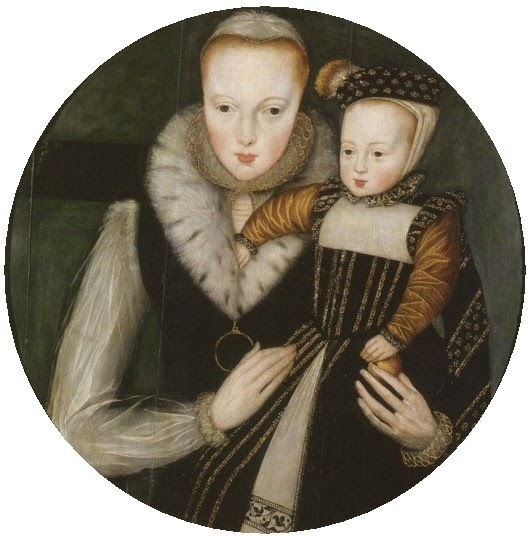
Lady Catherine GreyThe belle of the family

Lady Mary GrayThe sensible one but afflicted with spinal curvature and very short of stature.
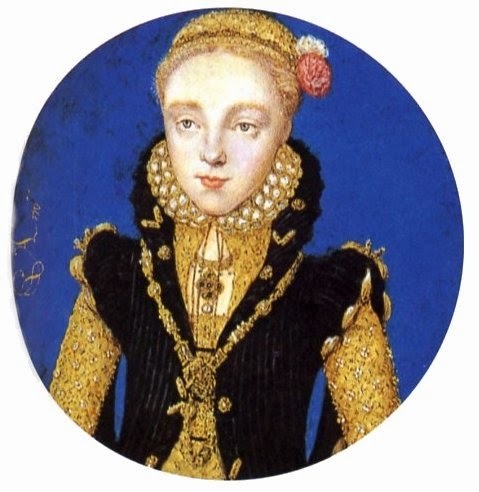
Levina TeerlincRoyal Painter of the Tudor Court
Book Review
by
Mirella Patzer
Sisters of Treason by Elizabeth Freemantle is set in 16th century England during a time of political upheaval. At the heart of the story are three women, the sisters Mary and Catherine Grey, and painter Levina Teerlinc. Through their collective points of view, the story unfolds. The main story plot are the struggles of the two sisters to avoid court intrigue and politics. Still reeling after the beheading of their Sister, Lady Jane Grey, Catherine and Mary find themselves pulled into court intrigue despite their attempts to keep their distance, where a single swipe of the quill or a few angry words, or even worse, the truth, will spill out and see them imprisoned in the Tower or executed.
Although I had not read the previous book, The Queen's Gambit, it made no difference – this story definitely stands alone. At first I was a little apprehensive because of the over-abundance of Tudor novels on the market currently, and I am getting a little weary of them, but I have to admit I was pleasantly surprised. The author has taken us deep into the viewpoint of two lesser known women in England’s history. So for that aspect alone, I found this book unique and refreshing. Brava Elizabeth Freemantle for bringing to life women other than those married to Henry VIII!
I did not expect to become so involved in this story, but I did. Lots of detail, spectacular writing, and an engaging plot kept me involved right to the very last page. Definitely a book not to overlook, especially if you are a fan of English history! I'm definitely looking forward to reading The Queen's Gambit!










From the author of Queen’s Gambit, which People magazine called, “A must-read for Philippa Gregory fans,” a gripping historical novel about two sisters who tread as dangerously close to the crown as their tragic sister, Lady Jane Grey, executed after just nine days on the throne.
Early in Mary Tudor’s turbulent reign, Lady Catherine and Lady Mary Grey are reeling after the brutal execution of their elder seventeen-year-old sister, Lady Jane Grey, and the succession is by no means stable. In Sisters of Treason, Elizabeth Freemantle brings these young women to life in a spellbinding Tudor tale of love and politics.
Neither sister is well suited to a dangerous life at court. Flirtatious Lady Catherine, thought to be the true heir, cannot control her compulsion to love and be loved. Her sister, clever Lady Mary, has a crooked spine and a tiny stature in an age when physical perfection equates to goodness—and both girls have inherited the Tudor blood that is more curse than blessing. For either girl to marry without royal permission would be a potentially fatal political act. It is the royal portrait painter, Levina Teerlinc, who helps the girls survive these troubled times. She becomes their mentor and confidante, but when the Queen’s sister, the hot-headed Elizabeth, inherits the crown, life at court becomes increasingly treacherous for the surviving Grey sisters. Ultimately each young woman must decide how far she will go to defy her Queen, risk her life, and find the safety and love she longs for.
From “a brilliant new player in the court of royal fiction,” (People) Sisters of Treason brings to vivid life the perilous and romantic lives of two little known young women who played a major role in the complex politics of their day.
Here are the four main historical women in the story!

Lady Jane Grey(Executed by beheading 9 days afer the start of her reign)

Lady Catherine GreyThe belle of the family

Lady Mary GrayThe sensible one but afflicted with spinal curvature and very short of stature.

Levina TeerlincRoyal Painter of the Tudor Court
Book Review
by
Mirella Patzer
Sisters of Treason by Elizabeth Freemantle is set in 16th century England during a time of political upheaval. At the heart of the story are three women, the sisters Mary and Catherine Grey, and painter Levina Teerlinc. Through their collective points of view, the story unfolds. The main story plot are the struggles of the two sisters to avoid court intrigue and politics. Still reeling after the beheading of their Sister, Lady Jane Grey, Catherine and Mary find themselves pulled into court intrigue despite their attempts to keep their distance, where a single swipe of the quill or a few angry words, or even worse, the truth, will spill out and see them imprisoned in the Tower or executed.
Although I had not read the previous book, The Queen's Gambit, it made no difference – this story definitely stands alone. At first I was a little apprehensive because of the over-abundance of Tudor novels on the market currently, and I am getting a little weary of them, but I have to admit I was pleasantly surprised. The author has taken us deep into the viewpoint of two lesser known women in England’s history. So for that aspect alone, I found this book unique and refreshing. Brava Elizabeth Freemantle for bringing to life women other than those married to Henry VIII!
I did not expect to become so involved in this story, but I did. Lots of detail, spectacular writing, and an engaging plot kept me involved right to the very last page. Definitely a book not to overlook, especially if you are a fan of English history! I'm definitely looking forward to reading The Queen's Gambit!









Published on July 18, 2014 10:38

